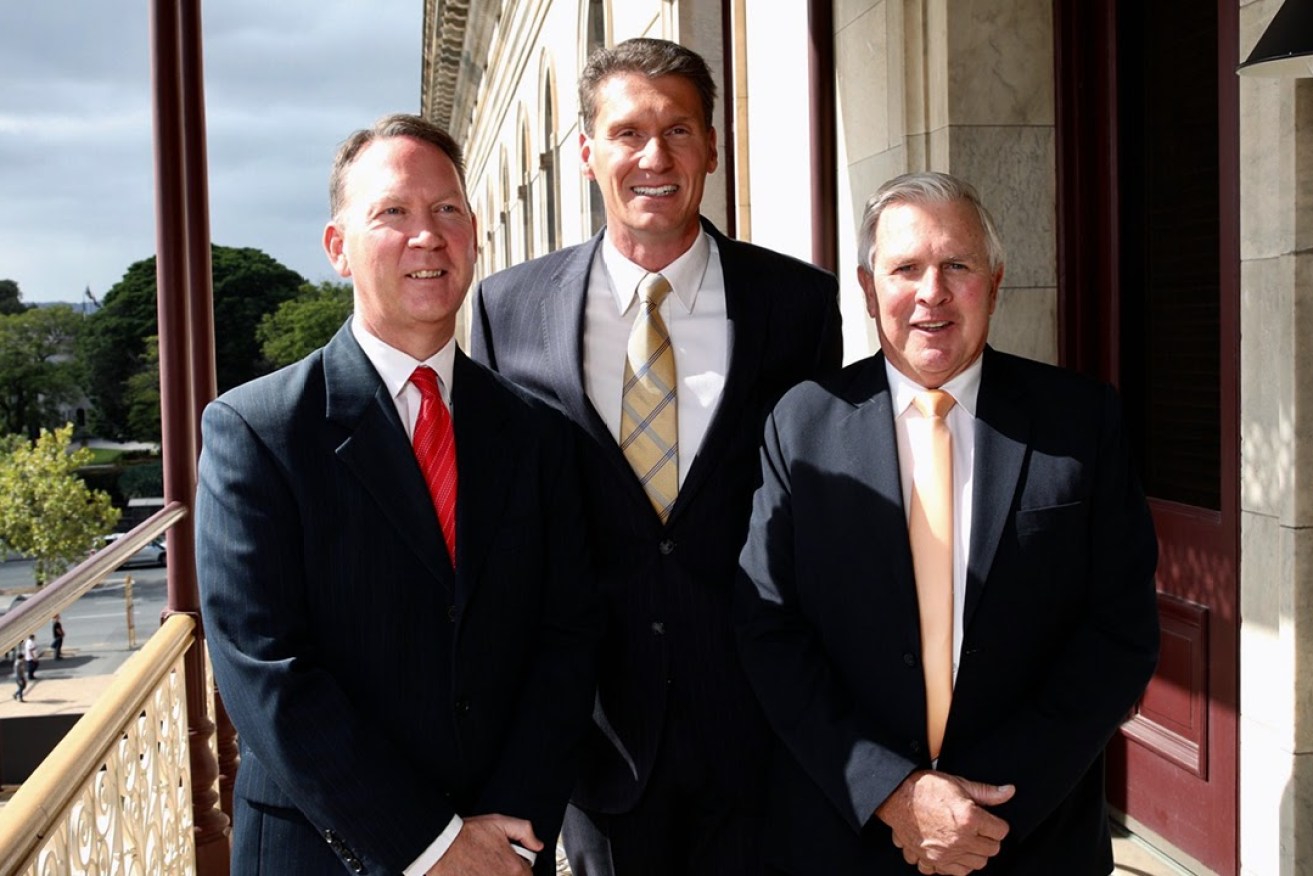New blow for Libs as Conservatives abandon lower house
In what looms as another electoral blow for the state Liberal Party, the fledgling Australian Conservatives are set to run candidates in as few as 10 lower house seats at the March election – a move that could cost the Opposition decisive preferences in a host of key seats.

Robert Brokenshire (right) with fellow Conservatives Dennis Hood and Cory Bernardi. Photo: Tony Lewis / InDaily
With Nick Xenophon splitting the primary vote – and creating a three-cornered contest in the 20 or more seats his SA Best is contesting – several party pundits have privately banked on preference flows from Cory Bernardi’s conservative party to help push the flagging Liberal vote above 50 per cent in several electorates previously regarded as blue-ribbon havens.
That’s based on the fact Family First – the Pentecostal-based Right-wing party that was last year subsumed by Australian Conservatives – ran in all-but-five of the state’s 47 House of Assembly seats at the previous election in 2014.
But MLC Robert Brokenshire – who is up for re-election in the Upper House – told InDaily the party was likely to run candidates in only around “10 to 15” lower house seats this time around.
“Our main focus is on the Upper House,” he said.
“That’s where we see us being able to do our best work… smaller parties of whatever colour, their role is in the house of review.”
InDaily revealed this week that Labor insiders believe up to 10 safe Liberal seats could be vulnerable to SA Best based on an analysis of Senate voting patterns from the 2016 federal election. In nine of those seats – Chaffey, Finniss, Hammond, Kavel, Morialta, Mount Gambier, Narungga (formerly Goyder), Schubert and Stuart – Family First ran a candidate in 2014, polling no lower than five per cent in any, and as high as 12.3 per cent in Schubert and 13.2 in Chaffey.
While much will depend on which seats the Australian Conservatives target, it likely represents the only significant minor party whose preferences will naturally flow to the Liberals, in an election in which the Opposition’s primary vote has already slumped as low as 29 per cent, according to last month’s Newspoll.
Brokenshire said the seats targeted would be “a mix of city and country”. But the Conservatives are likely to contest the seats in which their vote is strongest, in a bid to bolster the party’s Upper House vote and gain a quota to secure Brokenshire’s re-election.
Nonetheless, major party insiders say running fewer candidates could hurt not merely the Liberal two-party vote, but the Conservatives’ Upper House vote as well.
“That’s the reason we run in dead red [Labor] seats,” one Liberal said.
“What’s the fundamental benefit of doing all that? Upper House seats – that’s what it’s all about.”
Changes to state electoral laws have made fielding more candidates an expensive exercise, given the 2014 campaign was likely bankrolled in part by Family First benefactor Bob Day – who has subsequently resigned from the Senate and been declared bankrupt after the collapse of his building empire.
Day told InDaily it was “fairly well-publicised and public knowledge” that he had supported Family First financially but that there was no link to be drawn about the number of seats being contested.
“The reasons for running the number of seats is something you’d have to talk to them about [but] I don’t think there’s any secret that Australian Conservatives are well-funded… they’re going pretty well,” he said.
It’s unclear the exact impact the loss of Conservatives preferences would have on the Liberals. One insider told InDaily the fact Family First did not run a candidate in the 2014 Fisher by-election – a three-cornered contest in which Labor benefitted from preferences of both the Greens and the Democrats to prevail by nine votes – was a decisive contributing factor in that poll.
While some of the Conservatives’ lost primary vote would certainly drift back to the Liberals in their absence, much of it would likely go instead to SA Best.
By contrast, the Greens – whose preferences traditionally flow strongly to Labor – say they expect to field candidates in all 47 lower house seats.
My experience is 70 p.c. and it doesn’t make much difference whether @greensSA direct to Labor, direct to someone else or don’t direct, whether they have someone handing out HTVs on the booth or don’t have someone on the booth.
— Michael Atkinson (@MickAtko) January 6, 2018
While the five seats in which Family First did not run in 2014 were all Liberal-held – Adelaide, Bragg, Dunstan, Heysen and Unley – four of them are affluent, inner-suburban electorates. In each, Labor made significant ground on the Liberal incumbent with strong preference flows from both the Greens and Dignity for Disability.
While he initially suggested the SA election wouldn’t be a focus of his new party, Bernardi told The Australian in September he would likely run candidates in both upper and lower house seats at the March poll, saying: “SA needs a credible and principled alternative to politics as usual.”




